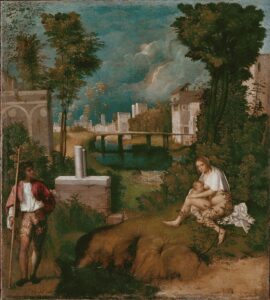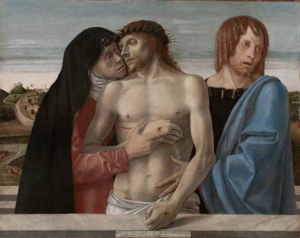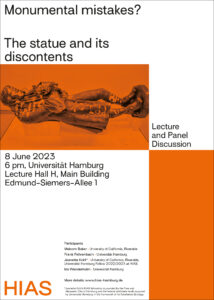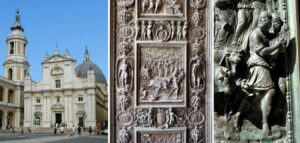Fourth Distinguished WAI Lecture on Renaissance Art and Culture
Wandering contemplation.
A new concept of the picture in the Venetian Renaissance, its medieval roots and some general considerations on the temporality of viewing
Prof. Dr. Johannes Grave, Department for Art History and Film Studies, Friedrich Schiller University Jena
Vice President (since 2024), Deutsche Forschungsgemeinschaft (DFG)/The German Research Foundation
Friday, 26 January 2024, 7.30-9.30 pm, UTC+8 Beijing, Shanghai, and Hong Kong, via Zoom
[11.30 am to 1.30 pm UTC+1, London; 12.30 to 2.30 pm, UTC+2, Berlin; 6.30 to 8.30 am, UTC-4, New York, Washington D.C.]

Giorgione, La Tempesta, c. 1508. Gallerie dell’Accademia, Venice
Around 1500, a “revolutionary novelty of pictorial language” (Salvatore Settis) can be observed in Venetian painting, which clearly deviates from the concept of “historia” as formulated by Leon Battista Alberti and implemented by early Renaissance painting, especially in Florence. Particularly in paintings by the old Giovanni Bellini, the early deceased Giorgione and the young Titian, there are hints of an alternative conception of what paintings can achieve. At the centre of this understanding is less an intellectual-scholarly ambition or the precise and reliable communication of certain thoughts than a form of perception in which viewing and contemplation are combined in a distinctive way. In addition to what a depiction gives us to see and reflect upon, i.e. the figures, actions and the meanings conveyed with them, what counts at least as much in Venetian pictorial culture is that a painting stimulates its audience to a specific doing and an unusual experience: to a thoughtful looking. The lecture will present this pictorial concept and ask to what extent it can be traced back to late medieval inspirations. The thesis will be put up for discussion that it is precisely the rather traditional cultural practice of Christian allegoresis from which essential impulses could be taken to arrive at a new conception of the possibilities of painting. This conception, in turn, was to become of great importance for the art of the early modern period. Pictures – as Venetian paintings show – cannot be reduced to being manifestations of a clearly predetermined meaning, but prove to be objects of open, temporally extending contemplation and reflection. Based on these observations, the concluding part of the lecture will outline more general considerations on the temporality of viewing pictures.
Registration
If you are residing outside mainland China and interested in attending this or other WAI lectures, please register for virtual participation: https://forms.gle/LAj5SkGCuy7Pgu1x9

 The Workshop series “The Concept of Style” Transdisciplinary Epistemologies in the Arts and Sciences, spearheaded by Dr. Johannes Endres and Dr. Erich Reck, unfolds a captivating exploration into the concept of style, traversing the realms of art, science, and philosophy.
The Workshop series “The Concept of Style” Transdisciplinary Epistemologies in the Arts and Sciences, spearheaded by Dr. Johannes Endres and Dr. Erich Reck, unfolds a captivating exploration into the concept of style, traversing the realms of art, science, and philosophy.
 For those concerned with the history of sculpture Robert Musil’s remark that “There is nothing in this world as invisible as a monument” has, alas, always rung very true.
For those concerned with the history of sculpture Robert Musil’s remark that “There is nothing in this world as invisible as a monument” has, alas, always rung very true. In 1564 Florentine monk and intellectual Vincenzo Borghini deemed basso rilievo the ‘dolce amaro’ of the arts: ‘sweet’ because sculptors might approach the capacity of painting to depict elements of an istoria, but also ‘bitter’ because relief could neither render a convincing painterly illusion of depth nor offer the multiple views of sculpture in the round. Borghini’s opinion of relief as a kind of ‘imperfect hybrid’ (Ostrow 2004, 336) is far from unique: indeed, such ambivalence typifies most writings on relief—themselves very few and far between—from the early modern period. Yet, as uneasy as art theoreticians were with this art form, relief permeated the built environment and daily lives of contemporary Italians, as it invested objects ranging from monumental architectural façades to miniature plaquettes. A partial and ‘imperfect’ amalgamation of painting and sculpture perhaps, but such in-betweenness allowed reliefs to use the means of both in order to engage viewers across an incredibly broad array of socio-spatial contexts. Foregrounding the idea of embodied spectatorship, my presentation will examine both textual accounts and artifacts that respond to particular aspects of such interaction, including that of a spectator’s mobility, tactile engagement, and the changeable environments that conditioned their encounters with relief sculpture. While similar, phenomenologically-oriented approaches have been fruitfully applied to the study of Renaissance sculpture in the round and even painting, these concerns remain underexplored with respect to relief sculpture. Here the production of the late 16th-century ‘Recanati School’ of bronze casters will form my primary case study: not only did these artists develop an unusually strong tradition of bronze relief, but their work spanned a wide variety of different socio-religious spaces—from doors, to chapel walls, to statue bases—in and around the Basilica della Santa Casa di Loreto.
In 1564 Florentine monk and intellectual Vincenzo Borghini deemed basso rilievo the ‘dolce amaro’ of the arts: ‘sweet’ because sculptors might approach the capacity of painting to depict elements of an istoria, but also ‘bitter’ because relief could neither render a convincing painterly illusion of depth nor offer the multiple views of sculpture in the round. Borghini’s opinion of relief as a kind of ‘imperfect hybrid’ (Ostrow 2004, 336) is far from unique: indeed, such ambivalence typifies most writings on relief—themselves very few and far between—from the early modern period. Yet, as uneasy as art theoreticians were with this art form, relief permeated the built environment and daily lives of contemporary Italians, as it invested objects ranging from monumental architectural façades to miniature plaquettes. A partial and ‘imperfect’ amalgamation of painting and sculpture perhaps, but such in-betweenness allowed reliefs to use the means of both in order to engage viewers across an incredibly broad array of socio-spatial contexts. Foregrounding the idea of embodied spectatorship, my presentation will examine both textual accounts and artifacts that respond to particular aspects of such interaction, including that of a spectator’s mobility, tactile engagement, and the changeable environments that conditioned their encounters with relief sculpture. While similar, phenomenologically-oriented approaches have been fruitfully applied to the study of Renaissance sculpture in the round and even painting, these concerns remain underexplored with respect to relief sculpture. Here the production of the late 16th-century ‘Recanati School’ of bronze casters will form my primary case study: not only did these artists develop an unusually strong tradition of bronze relief, but their work spanned a wide variety of different socio-religious spaces—from doors, to chapel walls, to statue bases—in and around the Basilica della Santa Casa di Loreto.